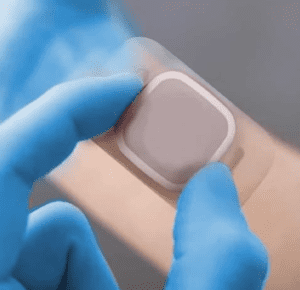
An Adhesive Solution For A Wearable Medical Device Patch
Introduction PolarSeal can develop and provide the adhesive tape and material needed to manufacture wearable medical devices, delivering high quality and innovative stick-to-skin solutions. We
Precision executed with a diverse range of fully validated capabilities

Introduction PolarSeal can develop and provide the adhesive tape and material needed to manufacture wearable medical devices, delivering high quality and innovative stick-to-skin solutions. We

Route to market for medical devices Quality and Regulatory getting you market ready PolarSeal® equips you with everything you need to take your medical device

The advent of Continuous Glucose Monitoring (CGM) patches has revolutionised diabetes management, offering patients a non-intrusive, real-time window into their glucose levels. This technology is

Digital transformation Driving change through innovation and investment in new technologies PolarSeal® is proud to be leading the way in the innovation of technologies with

Book a 1-on-1 video call with one of our converting specialists or submit your contact details and we will be in touch.
The need to know’s and the A’s to Z’s.

To change an adhesive film from a dry stage into a useful tacky state.
To bond; to cause two surfaces to be held together by adhesion.
The molecular force of attraction or bond between any adhesive and the surface it is in contact with. The strength of the attraction or bond is determined by the surface energy of the material and the type of adhesive involved.
The pressure-sensitive adhesive layer is applied to a tape which will usefully hold two surfaces together by intimate contact.
The inking system commonly employed in flexographic printing, consists of an elastomer-covered fountain roller running in the ink pan. Adjustable against an engraved anilox roll, the two as a unit are adjusted to the printing plate roll, ink is flooded into the engraved cells of the anilox roll, excess doctored off by the doctor blade and that which remains beneath the surface of the anilox roll is transferred to the printing plate.
Slits in the release liner to facilitate easy removal by hand.
The undesirable penetration of the adhesive onto the surface to which the tape is applied.
The amount of force required to separate the joined surfaces.
A splice made by joining tape end to end without overlapping. The splice is assembled by a thin single-coated tape centred on both sides.
A measurement of thickness expressed in thousands of an inch (English units) or millimetres (Metric units).
Scraps or tiny pieces of material removed from web during die cutting and/or sprocketing
Tape construction on which the carrier has on both sides an adhesive coating.
A photo-electric instrument that measures the optical density of images or colours. A reflection densitometer measures the amount of incident light reflecting from the surface of a substrate such as ink on paper or film. A transmission densitometer measures the amount of light transmitted through film from a measured light source.
The direction at right angles to the machine direction of a web through a machine.
An adjustable knife-like bar which controls the amount of ink, coating, adhesive, etc from the Anilox or other roller.
Double-coated tape with adhesive edge removed
The distance a tape will stretch lengthwise before breaking. Expressed as a percentage of original length. Elongation is not necessarily an indication of conformability.
To create a design on a surface caused by letters, figures, patterns, etc, to be raised by dies.
To expel or force through a measured orifice; to apply a molten thermoplastic adhesive onto a web.
The degree of stickiness of the adhesive is determined by touching with one’s finger. This is often a misleading test to determine adhesion.
Fibre Filled refers to an adhesive that has had fibre added to it. These fibres help in the conversion of the products, by preventing adhesive flow. Fibre filling does allow for as much elongation as a regular transfer tape. Fibre filling does not provide as much stability in conversion as a carrier product.
Flexo printing is a direct flat or rotary printing process with elastic, raised printing forms or plates, which can be attached to plates or printing cylinders of different circumferences. Ink is applied with a rubber roller and/or an anilox roller with a doctor blade and relatively high viscosity water, solvent-based or UV-curable printing inks. The system was initially developed at the beginning of the 19th century to print wallpaper. By the end of the 19th century, it was used for printing packaging paper and board. The name was chosen in 1952 and is derived from the earlier name of aniline printing, relating to the early types of inks used.
A super-calendered smooth dense transparent or semi-transparent paper.
The machine direction of paper as opposed to the cross direction. Also, a measurement of pressure-sensitive adhesive on a given area.
Applies a specific amount of coating controlled by an etched roll to a surface.
A controlled environment to provide an indication of any deterioration of an end-use or finished product.
The liner is more difficult to remove from the adhesive/carrier producing high-release adhesion.
The molecular force of attraction or bond between any adhesive and the surface it is in contact with. The strength of the attraction or bond is determined by the surface energy of the material and the type of adhesive involved.
A pressure-sensitive adhesive applied to the liner or backing in a hot molten form which cools to form a conventional pressure-sensitive adhesive.
Special types of pressure-sensitive adhesives are particularly used in the medical field due to their unique dual attributes of absorbency and adhesiveness.
Die cut pieces cut right through tape and liner or using the exact width of tape required and guillotining at a set length to produce finished parts.
Kiss-cutting refers to a die cutting method where the die cuts through the laminated material and adhesive and stops before rupturing the liner. In this process, the waste matrix is often removed.
A backing coated on one or both sides that protects the adhesive until use. The liner is removed and discarded before application. Most frequently found on double-coated tapes and labels.
The total construction of a pressure-sensitive adhesive system surrounding a die-cut form which has been removed.
The property of a material that attempts to return to its original dimension after being distorted.
Used in describing adhesive coat weights, and thickness. The term means thousandths of an inch.
A substance added to materials to impart flexibility.
A strong film having good resistance to moisture, solvents and many other chemicals. It is usually clear and can be purchased in different mil thickness.
A large molecular chain made up of identical monomer units, produces a film forming elastomer. This is the base material of films and adhesives.
A term used to designate a distinct category of adhesive tapes which in dry (solvent-free) form are aggressive and permanently tacky at room temperature and adhere to a variety of surfaces without the need for more than finger or hand pressure. They require no activation by water, solvent or heat and have sufficient cohesive strength so they can be handled with the fingers.
A very thin chemical coating applied to the release liner during its manufacture which renders it suitable to perform its role of allowing an adhesive tape to be unwound prior to use.
A backing coated on one or both sides that protects the adhesive until use. The liner is removed and discarded before application. Most frequently found on double-coated tapes and labels.
Usually a polymer that imparts tackiness and adhesion to a pressure-sensitive adhesive.
The ability of a tape to resist slippage under shear stress. It is measured by applying a standard area of tape to a vertical test panel and suspending a standard weight on the bottom portion of the tape. Measurement is given in minutes till failure and or distance slip.
A release-treated sheet used to protect the edges of rolls from sticking to each other while stacked.
In pressure-sensitive technology, it is the liquid used to dissolve various adhesive ingredients to facilitate their application to a substrate during coating.
The process of winding narrow slit widths of tape much like a fishing line is wound on a reel.
Holes punched in oversized liner to accommodate automatic feed and placing of die cut parts.
Die cut pieces kiss cut on a roll with surrounding waste material taken away.
Surface Energy is a term typically used to describe the ease with which a material can be made pressure-sensitive. High Surface Energy materials like metals are usually easier to bond to than Low Surface Energy materials like polypropylene. Surface Energy is measured in Dynes per square centimetre.
The force required to break a piece of tape by pulling on opposite ends. Results are usually expressed in pounds per inch width in the machine direction.
High or tight release means the liner is more difficult to remove from the carrier/liner producing high-release adhesion.
Typically referred to as a carrier in a double-coated product. A tissue carrier can make slitting and die cutting easier, by preventing adhesive flow. Tissue differs from film carriers in that it does allow for some elongation and permits more conformability.
Normally refers to “adhesive transfer”. Any tape component which moves from its proper place to some other position during unwinding or removal.